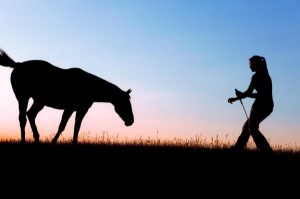
How to Lunge a Horse in Preparation for a Rider
It is very important to warm a horse up on the lunge before mounting the rider ready for lungeing exercises.
Lunging the horse before mounting the rider will allow the horse to warm up, provide an opportunity for you to check for any lameness (there is nothing more time consuming when lunging a horse than getting the rider settled on the horse only to realise the horse is lame). It is also important for the rider doing the lunging exercises to ensure the horse is not be fresh (excitable).
The horse needs to be lunged in walk, trot and canter (even if the rider will not be cantering) by doing so you will make sure the horse will respond to your commands and be controllable in all three paces.
If you are going to use lunge rein when the rider gets on then you need to warm the horse up with side reins, again this is for safety reasons: to make sure the horse will work calmly with the side reins on, it is no good to test this theory out once you have a rider on the horse.
In regards to training of the horse, it is good to lunge the horse in both directions (i.e. to work the muscle groups on both sides of the horse evenly) however to lunge a horse in both directions in a thirty minute lesson is time consuming so unless the horse is particularly fresh or if you expect lameness lunging through all three paces in one direction should be adequate.
While you are lunging the horse ensure the rider is waiting outside of the lunging area and are not hanging through or sitting on the fence. The reason for this is that if the rider is waiting inside the arena there is the risk that the horse may run over them or kick out at them as they go past. They may also become injured from hanging through or falling off the fence. In addition it is not a good idea to have the rider stand in the middle with you while you lunge as it is easy to loose awareness of where they are around you.
Safety Procedures for lunging horses in preparation for a rider:
- Ensure the gate to the arena is closed and direct the rider on an appropriate and safe place to wait until you are finished.
- They horse should be saddled and bridled (with or without a lunging cavesson and side reins). Attach the lunge rein (if it is not already attached).
- Secure the reins so that if the horse puts it’s head down it will not become entangled in them. This can be done in a couple of ways
- Unbuckle the reins, wrap them around the horses’ neck (around the gullet) then re-buckle them around themselves
- If the saddle has a monkey rein/grip (strap that is fixed across the pommel of the saddle) the reins can be unbuckled then re-buckled around the monkey grip then twist the reins around and pass the throatlatch through them to keep them up away from the horses’ legs.
- Check the firmness of the girth.
- Secure the stirrups so they do not unravel and hit the horses’ elbows. This can be done in a couple of ways
a) left down the stirrups and lie them over the seat of the saddle (this is quick & easy but they made flick back once the horse is in motion)
b) Leave the stirrup run up, take the loop of the stirrup leather and pass it under the top of the leather (it will now loop around the stirrup iron and under the top of the stirrup leather) then thread the tail end of the stirrup leather through the loop of the stirrup leather and push it back through the keeper on the saddle. - Attach the side reins. Outside first, then inside. (If you are going to lunge the horse on the left rein (i.e. to the left) then you would attach the right side rein before the left. (Alternatively the horse can be warmed up first without the side-reins then with the side-reins).
- When you move the horse off ensure the horse steps away from you and not you stepping backwards away from the horse. At no time when you are teaching or lunging should you walk backwards.
- Allow the horse adequate time to warm-up in each pace before moving onto the faster pace.
- Give loud, clear voice commands (i.e. “trot on” and “whoa”) followed by a flick of the lunge whip is the horse doesn’t respond. Encourage the horse to go forward so that you know if the horse is going to react or be fresh in response.
- While lunging the horse, lunge whip and lunge rein should form a triangle with you at the point of it. The lunge rein should never touch the ground and the lunge whip should be directed towards the horses’ hocks when moving. Pressure on the lunge rein can be used to assist in encouraging the horse to slow down, if this doesn’t work decrease the size of the circle.
- Once you have warmed the horse up in walk, trot and canter return the horse to halt. This should be done progressively through the paces and with the horse in control, not just mindlessly cantering around in circles.
- At the halt remove the side reins while the rider mounts ready for horse riding exercises. To remove them you will detach the inside first, then the outside. Make sure they are secured and not left to hang around the horses’ legs.
- Recheck the girth before the rider mounts
- When you are learning how to lunge a horse, if it is with a rider doing horse riding exercises or if you are lunging horses for the lunging exercises is to continue to be aware of risk. There are lots of other things that can go wrong but the main safety areas are listed above.

